Business Project Management Report: Bromic Group's Global Social Media
VerifiedAdded on 2020/04/21
|16
|3893
|59
Report
AI Summary
This report analyzes the challenges faced by the Bromic Group, a Sydney-based manufacturing company, in developing a global social media strategy. The report examines the company's need to expand its reach through social media marketing, addressing issues such as establishing a global social media structure, defining guidelines for business units and the corporate sector, identifying appropriate social media channels, and localizing content while maintaining centralized control. The analysis employs the McKinsey Way, breaking down the issues into sub-issues and utilizing fact-based analysis, rigid structuring, and hypothesis-driven approaches. The report explores the impact of technology on business, providing case studies and proposing feasible solutions to help the Bromic Group overcome its challenges and effectively manage its social media presence for global business growth. The report covers a detailed analysis of the issues using the McKinsey's Way, fact-based analysis, rigid structuring, initial hypothesis, and work plan. Finally, the report presents feasible solutions that might help the company deal with business and corporate model issues.
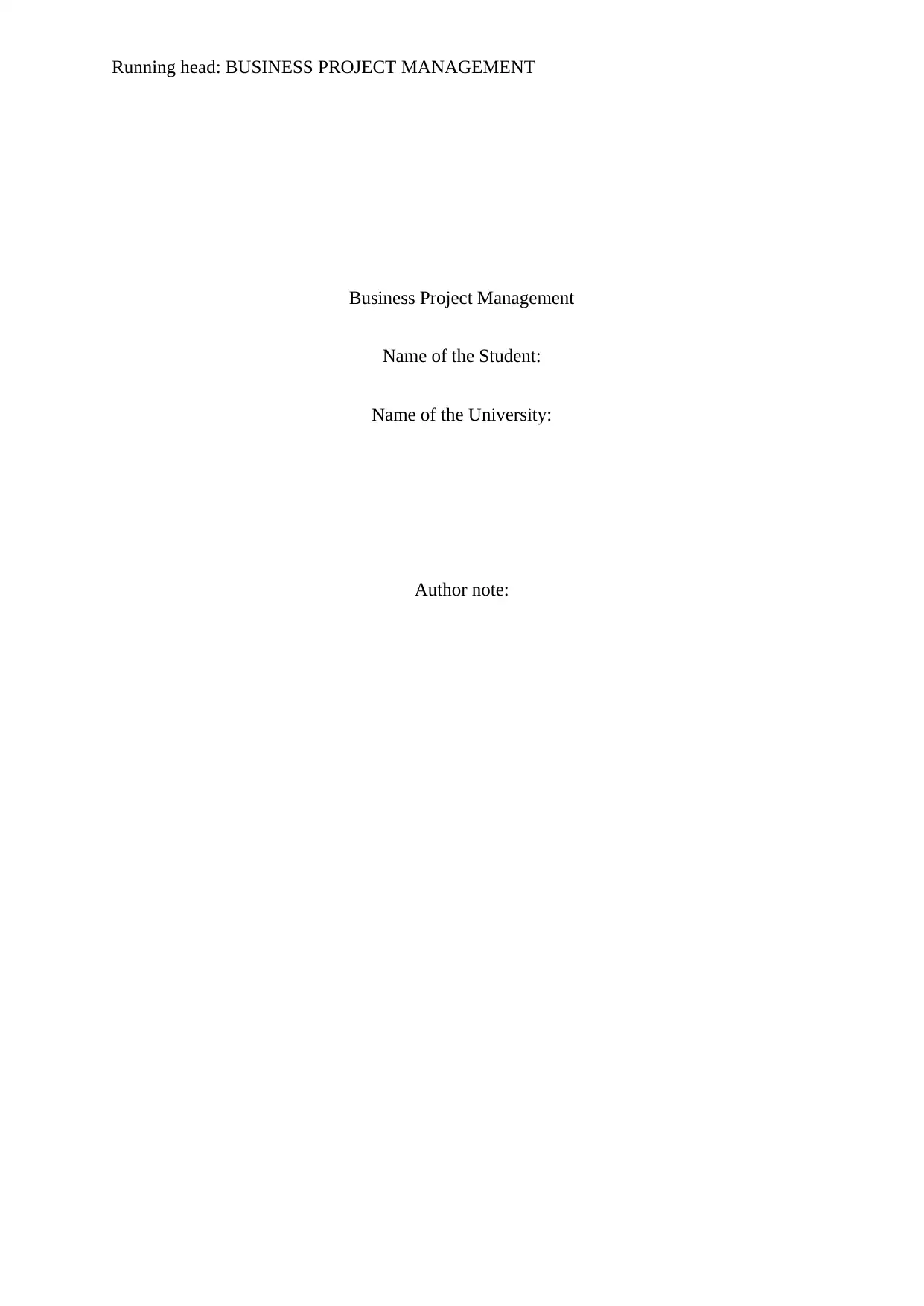
Running head: BUSINESS PROJECT MANAGEMENT
Business Project Management
Name of the Student:
Name of the University:
Author note:
Business Project Management
Name of the Student:
Name of the University:
Author note:
Secure Best Marks with AI Grader
Need help grading? Try our AI Grader for instant feedback on your assignments.
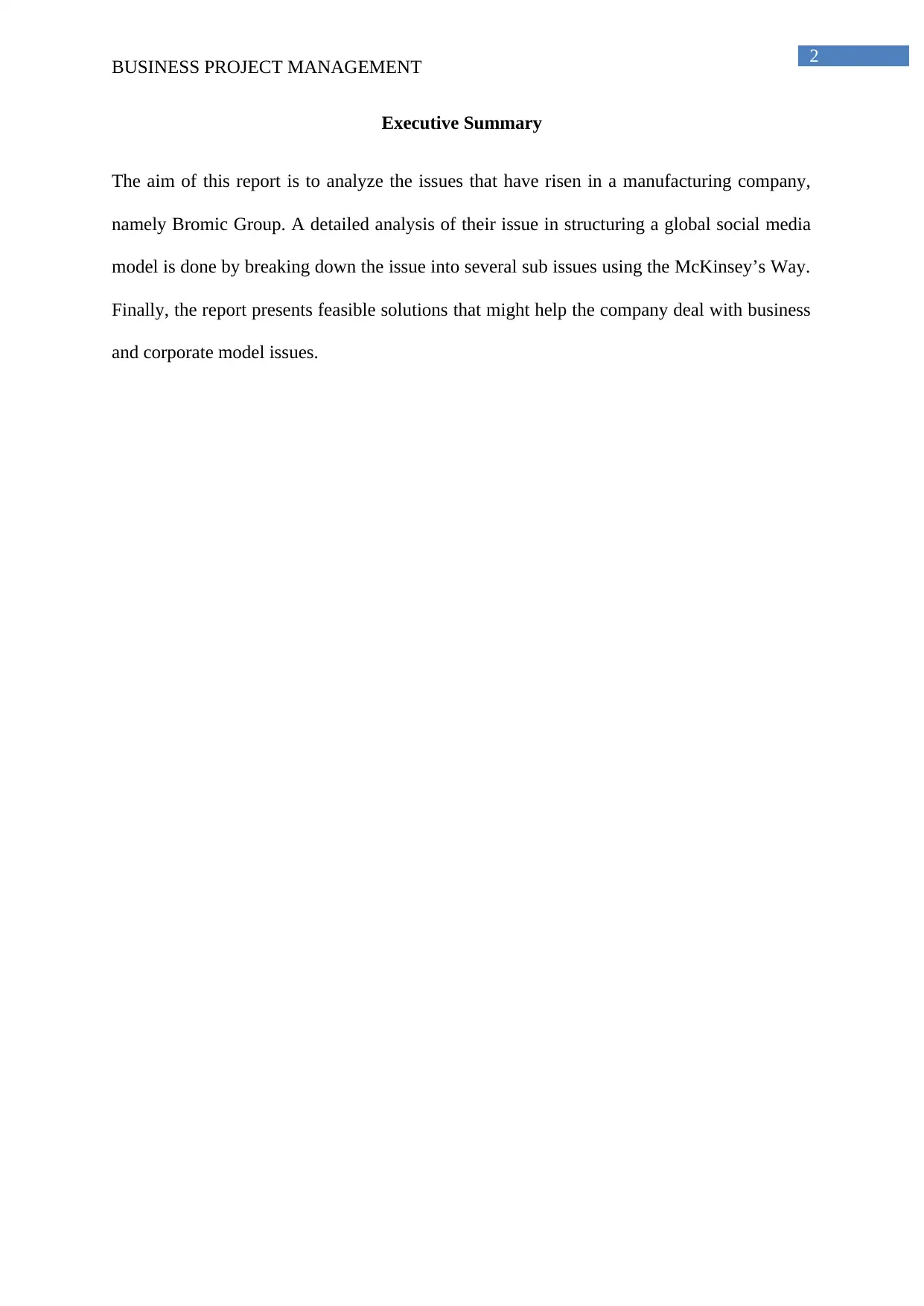
2
BUSINESS PROJECT MANAGEMENT
Executive Summary
The aim of this report is to analyze the issues that have risen in a manufacturing company,
namely Bromic Group. A detailed analysis of their issue in structuring a global social media
model is done by breaking down the issue into several sub issues using the McKinsey’s Way.
Finally, the report presents feasible solutions that might help the company deal with business
and corporate model issues.
BUSINESS PROJECT MANAGEMENT
Executive Summary
The aim of this report is to analyze the issues that have risen in a manufacturing company,
namely Bromic Group. A detailed analysis of their issue in structuring a global social media
model is done by breaking down the issue into several sub issues using the McKinsey’s Way.
Finally, the report presents feasible solutions that might help the company deal with business
and corporate model issues.
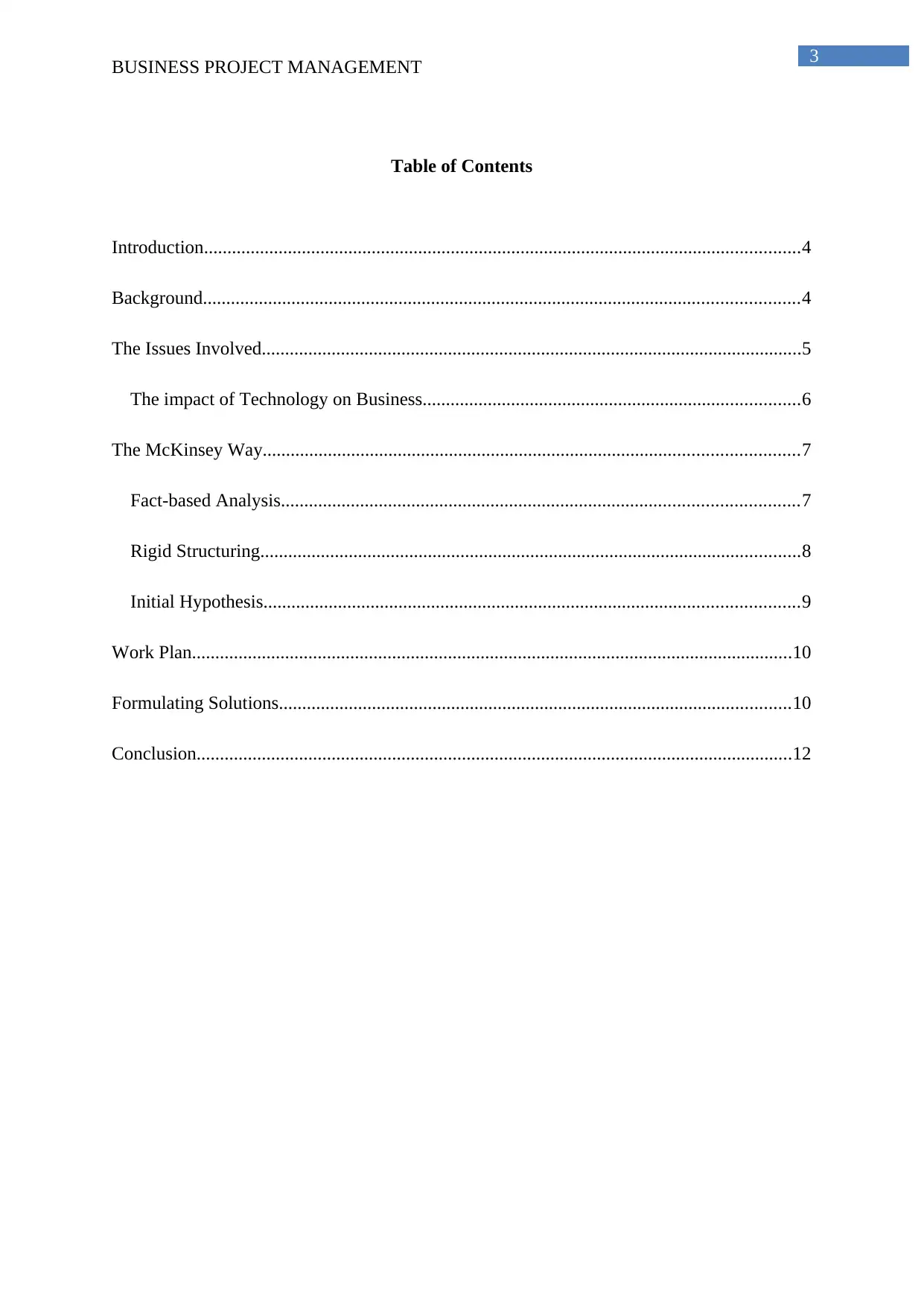
3
BUSINESS PROJECT MANAGEMENT
Table of Contents
Introduction................................................................................................................................4
Background................................................................................................................................4
The Issues Involved....................................................................................................................5
The impact of Technology on Business.................................................................................6
The McKinsey Way...................................................................................................................7
Fact-based Analysis...............................................................................................................7
Rigid Structuring....................................................................................................................8
Initial Hypothesis...................................................................................................................9
Work Plan.................................................................................................................................10
Formulating Solutions..............................................................................................................10
Conclusion................................................................................................................................12
BUSINESS PROJECT MANAGEMENT
Table of Contents
Introduction................................................................................................................................4
Background................................................................................................................................4
The Issues Involved....................................................................................................................5
The impact of Technology on Business.................................................................................6
The McKinsey Way...................................................................................................................7
Fact-based Analysis...............................................................................................................7
Rigid Structuring....................................................................................................................8
Initial Hypothesis...................................................................................................................9
Work Plan.................................................................................................................................10
Formulating Solutions..............................................................................................................10
Conclusion................................................................................................................................12
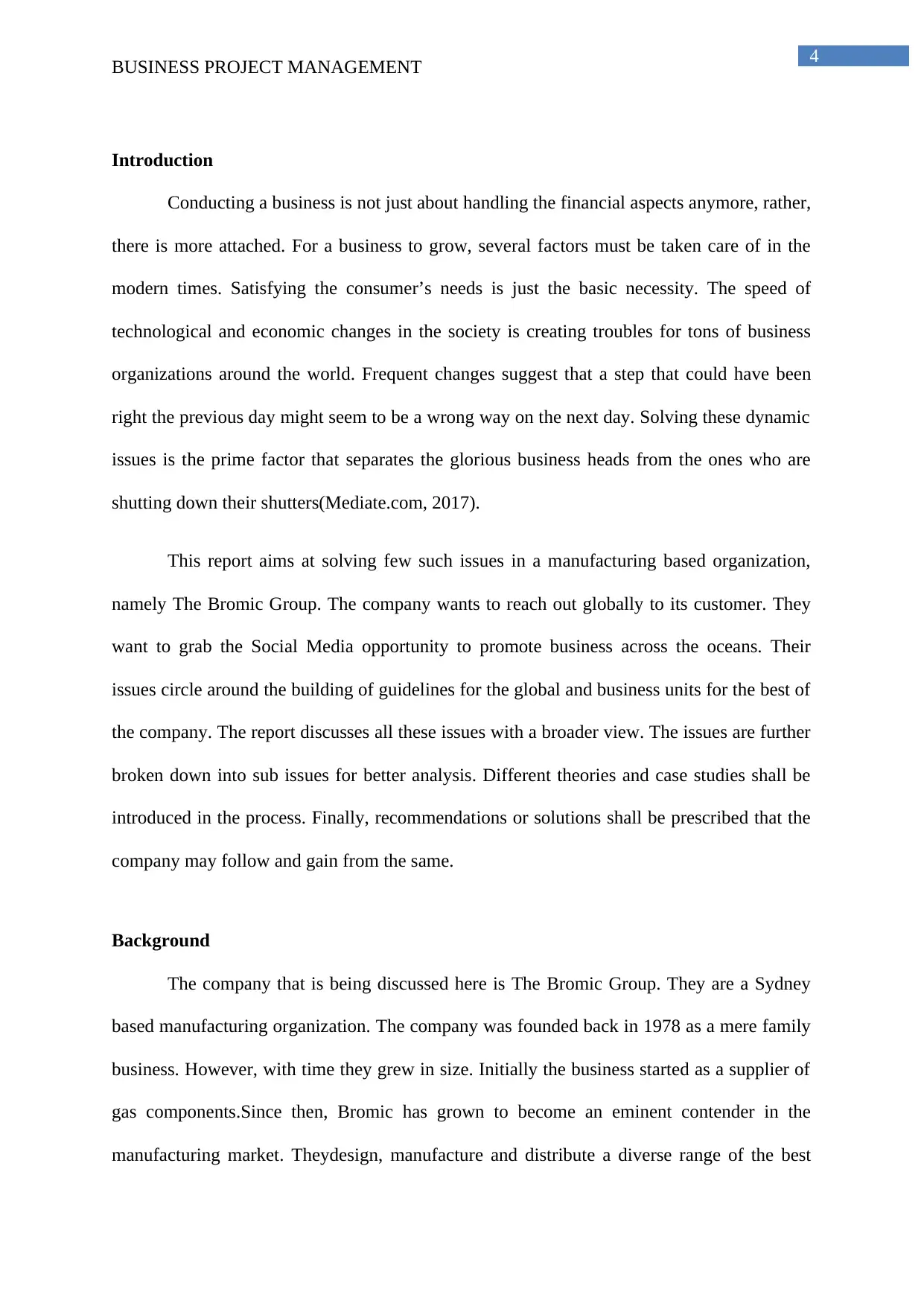
4
BUSINESS PROJECT MANAGEMENT
Introduction
Conducting a business is not just about handling the financial aspects anymore, rather,
there is more attached. For a business to grow, several factors must be taken care of in the
modern times. Satisfying the consumer’s needs is just the basic necessity. The speed of
technological and economic changes in the society is creating troubles for tons of business
organizations around the world. Frequent changes suggest that a step that could have been
right the previous day might seem to be a wrong way on the next day. Solving these dynamic
issues is the prime factor that separates the glorious business heads from the ones who are
shutting down their shutters(Mediate.com, 2017).
This report aims at solving few such issues in a manufacturing based organization,
namely The Bromic Group. The company wants to reach out globally to its customer. They
want to grab the Social Media opportunity to promote business across the oceans. Their
issues circle around the building of guidelines for the global and business units for the best of
the company. The report discusses all these issues with a broader view. The issues are further
broken down into sub issues for better analysis. Different theories and case studies shall be
introduced in the process. Finally, recommendations or solutions shall be prescribed that the
company may follow and gain from the same.
Background
The company that is being discussed here is The Bromic Group. They are a Sydney
based manufacturing organization. The company was founded back in 1978 as a mere family
business. However, with time they grew in size. Initially the business started as a supplier of
gas components.Since then, Bromic has grown to become an eminent contender in the
manufacturing market. Theydesign, manufacture and distribute a diverse range of the best
BUSINESS PROJECT MANAGEMENT
Introduction
Conducting a business is not just about handling the financial aspects anymore, rather,
there is more attached. For a business to grow, several factors must be taken care of in the
modern times. Satisfying the consumer’s needs is just the basic necessity. The speed of
technological and economic changes in the society is creating troubles for tons of business
organizations around the world. Frequent changes suggest that a step that could have been
right the previous day might seem to be a wrong way on the next day. Solving these dynamic
issues is the prime factor that separates the glorious business heads from the ones who are
shutting down their shutters(Mediate.com, 2017).
This report aims at solving few such issues in a manufacturing based organization,
namely The Bromic Group. The company wants to reach out globally to its customer. They
want to grab the Social Media opportunity to promote business across the oceans. Their
issues circle around the building of guidelines for the global and business units for the best of
the company. The report discusses all these issues with a broader view. The issues are further
broken down into sub issues for better analysis. Different theories and case studies shall be
introduced in the process. Finally, recommendations or solutions shall be prescribed that the
company may follow and gain from the same.
Background
The company that is being discussed here is The Bromic Group. They are a Sydney
based manufacturing organization. The company was founded back in 1978 as a mere family
business. However, with time they grew in size. Initially the business started as a supplier of
gas components.Since then, Bromic has grown to become an eminent contender in the
manufacturing market. Theydesign, manufacture and distribute a diverse range of the best
Secure Best Marks with AI Grader
Need help grading? Try our AI Grader for instant feedback on your assignments.
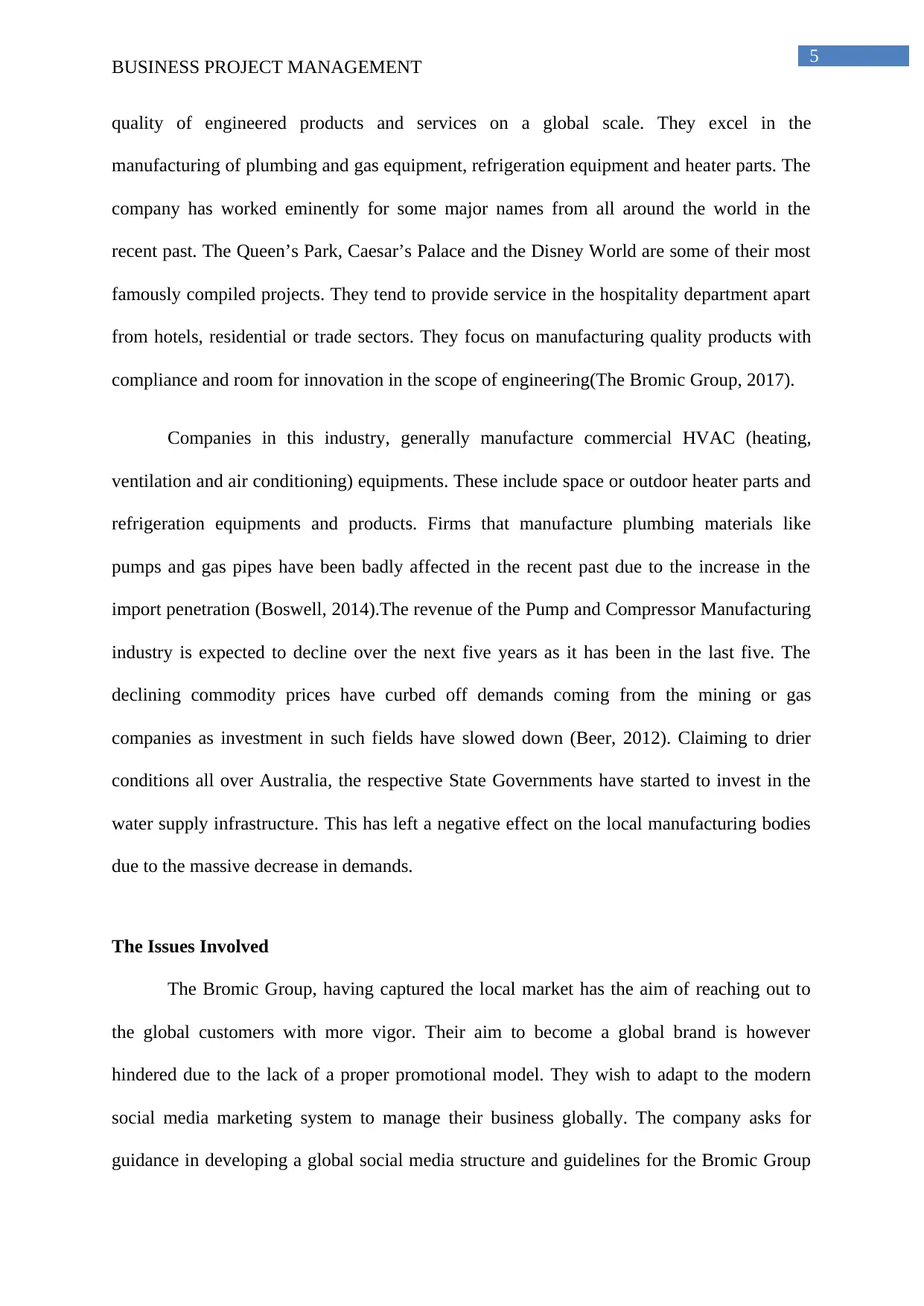
5
BUSINESS PROJECT MANAGEMENT
quality of engineered products and services on a global scale. They excel in the
manufacturing of plumbing and gas equipment, refrigeration equipment and heater parts. The
company has worked eminently for some major names from all around the world in the
recent past. The Queen’s Park, Caesar’s Palace and the Disney World are some of their most
famously compiled projects. They tend to provide service in the hospitality department apart
from hotels, residential or trade sectors. They focus on manufacturing quality products with
compliance and room for innovation in the scope of engineering(The Bromic Group, 2017).
Companies in this industry, generally manufacture commercial HVAC (heating,
ventilation and air conditioning) equipments. These include space or outdoor heater parts and
refrigeration equipments and products. Firms that manufacture plumbing materials like
pumps and gas pipes have been badly affected in the recent past due to the increase in the
import penetration (Boswell, 2014).The revenue of the Pump and Compressor Manufacturing
industry is expected to decline over the next five years as it has been in the last five. The
declining commodity prices have curbed off demands coming from the mining or gas
companies as investment in such fields have slowed down (Beer, 2012). Claiming to drier
conditions all over Australia, the respective State Governments have started to invest in the
water supply infrastructure. This has left a negative effect on the local manufacturing bodies
due to the massive decrease in demands.
The Issues Involved
The Bromic Group, having captured the local market has the aim of reaching out to
the global customers with more vigor. Their aim to become a global brand is however
hindered due to the lack of a proper promotional model. They wish to adapt to the modern
social media marketing system to manage their business globally. The company asks for
guidance in developing a global social media structure and guidelines for the Bromic Group
BUSINESS PROJECT MANAGEMENT
quality of engineered products and services on a global scale. They excel in the
manufacturing of plumbing and gas equipment, refrigeration equipment and heater parts. The
company has worked eminently for some major names from all around the world in the
recent past. The Queen’s Park, Caesar’s Palace and the Disney World are some of their most
famously compiled projects. They tend to provide service in the hospitality department apart
from hotels, residential or trade sectors. They focus on manufacturing quality products with
compliance and room for innovation in the scope of engineering(The Bromic Group, 2017).
Companies in this industry, generally manufacture commercial HVAC (heating,
ventilation and air conditioning) equipments. These include space or outdoor heater parts and
refrigeration equipments and products. Firms that manufacture plumbing materials like
pumps and gas pipes have been badly affected in the recent past due to the increase in the
import penetration (Boswell, 2014).The revenue of the Pump and Compressor Manufacturing
industry is expected to decline over the next five years as it has been in the last five. The
declining commodity prices have curbed off demands coming from the mining or gas
companies as investment in such fields have slowed down (Beer, 2012). Claiming to drier
conditions all over Australia, the respective State Governments have started to invest in the
water supply infrastructure. This has left a negative effect on the local manufacturing bodies
due to the massive decrease in demands.
The Issues Involved
The Bromic Group, having captured the local market has the aim of reaching out to
the global customers with more vigor. Their aim to become a global brand is however
hindered due to the lack of a proper promotional model. They wish to adapt to the modern
social media marketing system to manage their business globally. The company asks for
guidance in developing a global social media structure and guidelines for the Bromic Group
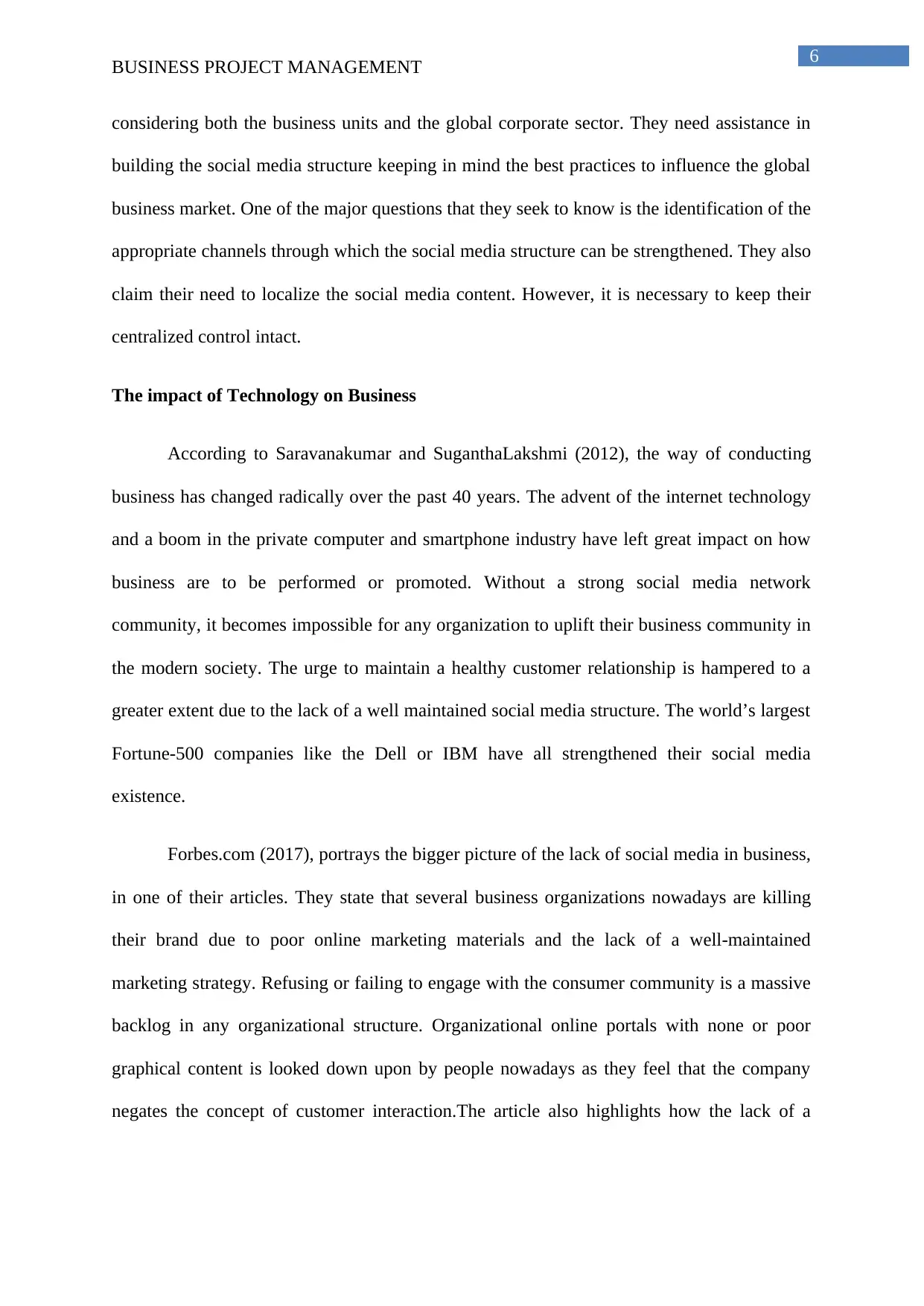
6
BUSINESS PROJECT MANAGEMENT
considering both the business units and the global corporate sector. They need assistance in
building the social media structure keeping in mind the best practices to influence the global
business market. One of the major questions that they seek to know is the identification of the
appropriate channels through which the social media structure can be strengthened. They also
claim their need to localize the social media content. However, it is necessary to keep their
centralized control intact.
The impact of Technology on Business
According to Saravanakumar and SuganthaLakshmi (2012), the way of conducting
business has changed radically over the past 40 years. The advent of the internet technology
and a boom in the private computer and smartphone industry have left great impact on how
business are to be performed or promoted. Without a strong social media network
community, it becomes impossible for any organization to uplift their business community in
the modern society. The urge to maintain a healthy customer relationship is hampered to a
greater extent due to the lack of a well maintained social media structure. The world’s largest
Fortune-500 companies like the Dell or IBM have all strengthened their social media
existence.
Forbes.com (2017), portrays the bigger picture of the lack of social media in business,
in one of their articles. They state that several business organizations nowadays are killing
their brand due to poor online marketing materials and the lack of a well-maintained
marketing strategy. Refusing or failing to engage with the consumer community is a massive
backlog in any organizational structure. Organizational online portals with none or poor
graphical content is looked down upon by people nowadays as they feel that the company
negates the concept of customer interaction.The article also highlights how the lack of a
BUSINESS PROJECT MANAGEMENT
considering both the business units and the global corporate sector. They need assistance in
building the social media structure keeping in mind the best practices to influence the global
business market. One of the major questions that they seek to know is the identification of the
appropriate channels through which the social media structure can be strengthened. They also
claim their need to localize the social media content. However, it is necessary to keep their
centralized control intact.
The impact of Technology on Business
According to Saravanakumar and SuganthaLakshmi (2012), the way of conducting
business has changed radically over the past 40 years. The advent of the internet technology
and a boom in the private computer and smartphone industry have left great impact on how
business are to be performed or promoted. Without a strong social media network
community, it becomes impossible for any organization to uplift their business community in
the modern society. The urge to maintain a healthy customer relationship is hampered to a
greater extent due to the lack of a well maintained social media structure. The world’s largest
Fortune-500 companies like the Dell or IBM have all strengthened their social media
existence.
Forbes.com (2017), portrays the bigger picture of the lack of social media in business,
in one of their articles. They state that several business organizations nowadays are killing
their brand due to poor online marketing materials and the lack of a well-maintained
marketing strategy. Refusing or failing to engage with the consumer community is a massive
backlog in any organizational structure. Organizational online portals with none or poor
graphical content is looked down upon by people nowadays as they feel that the company
negates the concept of customer interaction.The article also highlights how the lack of a
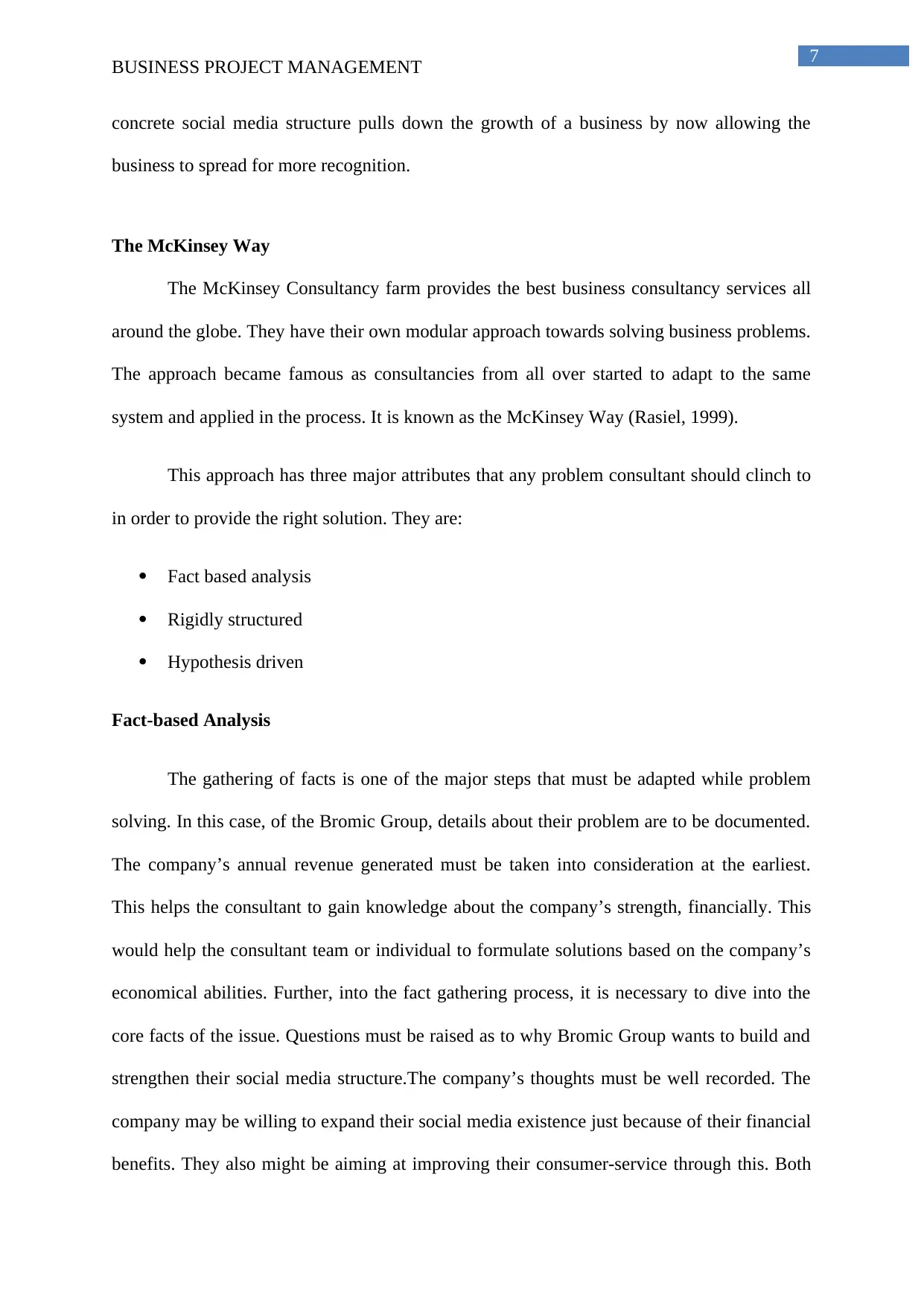
7
BUSINESS PROJECT MANAGEMENT
concrete social media structure pulls down the growth of a business by now allowing the
business to spread for more recognition.
The McKinsey Way
The McKinsey Consultancy farm provides the best business consultancy services all
around the globe. They have their own modular approach towards solving business problems.
The approach became famous as consultancies from all over started to adapt to the same
system and applied in the process. It is known as the McKinsey Way (Rasiel, 1999).
This approach has three major attributes that any problem consultant should clinch to
in order to provide the right solution. They are:
Fact based analysis
Rigidly structured
Hypothesis driven
Fact-based Analysis
The gathering of facts is one of the major steps that must be adapted while problem
solving. In this case, of the Bromic Group, details about their problem are to be documented.
The company’s annual revenue generated must be taken into consideration at the earliest.
This helps the consultant to gain knowledge about the company’s strength, financially. This
would help the consultant team or individual to formulate solutions based on the company’s
economical abilities. Further, into the fact gathering process, it is necessary to dive into the
core facts of the issue. Questions must be raised as to why Bromic Group wants to build and
strengthen their social media structure.The company’s thoughts must be well recorded. The
company may be willing to expand their social media existence just because of their financial
benefits. They also might be aiming at improving their consumer-service through this. Both
BUSINESS PROJECT MANAGEMENT
concrete social media structure pulls down the growth of a business by now allowing the
business to spread for more recognition.
The McKinsey Way
The McKinsey Consultancy farm provides the best business consultancy services all
around the globe. They have their own modular approach towards solving business problems.
The approach became famous as consultancies from all over started to adapt to the same
system and applied in the process. It is known as the McKinsey Way (Rasiel, 1999).
This approach has three major attributes that any problem consultant should clinch to
in order to provide the right solution. They are:
Fact based analysis
Rigidly structured
Hypothesis driven
Fact-based Analysis
The gathering of facts is one of the major steps that must be adapted while problem
solving. In this case, of the Bromic Group, details about their problem are to be documented.
The company’s annual revenue generated must be taken into consideration at the earliest.
This helps the consultant to gain knowledge about the company’s strength, financially. This
would help the consultant team or individual to formulate solutions based on the company’s
economical abilities. Further, into the fact gathering process, it is necessary to dive into the
core facts of the issue. Questions must be raised as to why Bromic Group wants to build and
strengthen their social media structure.The company’s thoughts must be well recorded. The
company may be willing to expand their social media existence just because of their financial
benefits. They also might be aiming at improving their consumer-service through this. Both
Paraphrase This Document
Need a fresh take? Get an instant paraphrase of this document with our AI Paraphraser
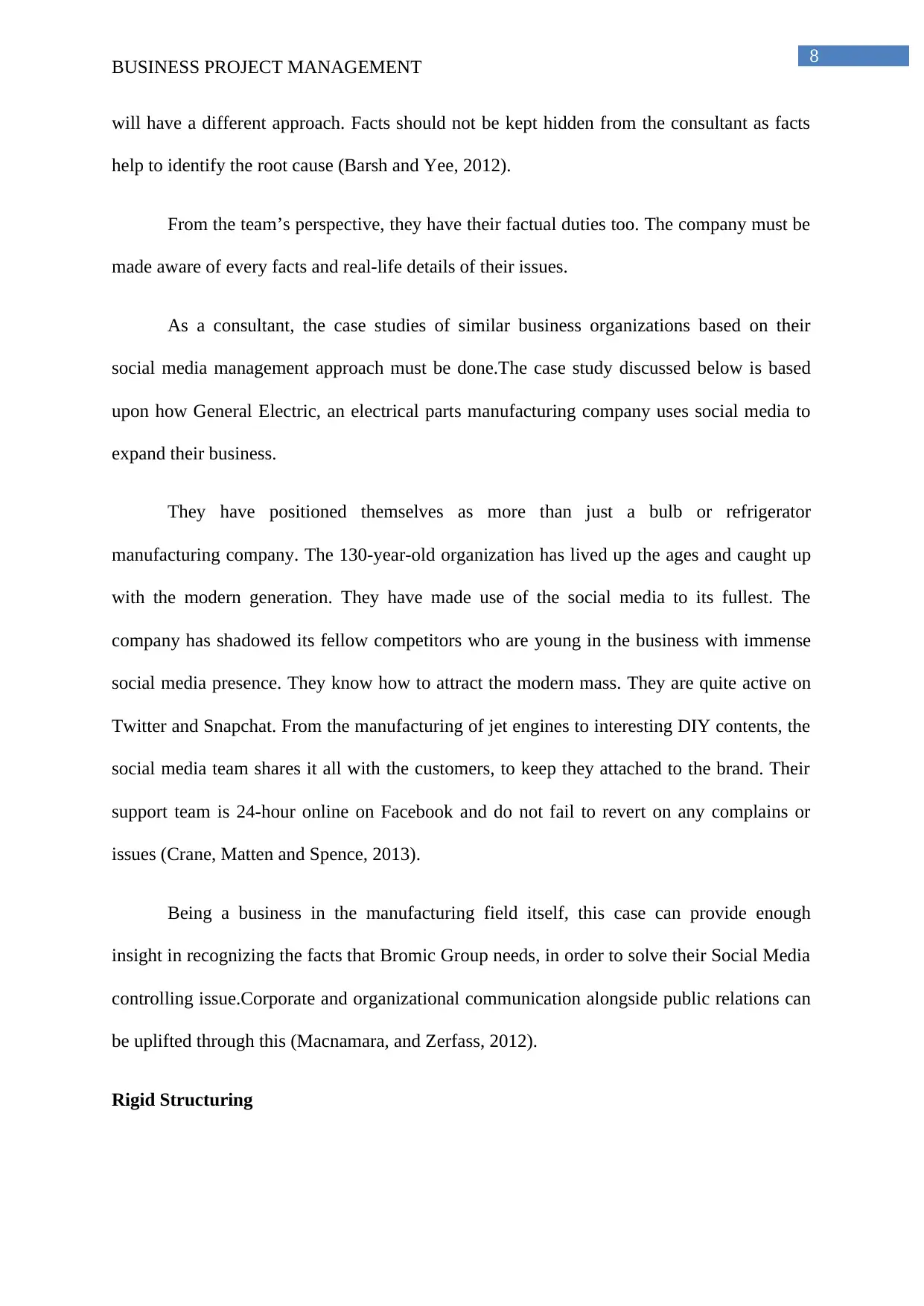
8
BUSINESS PROJECT MANAGEMENT
will have a different approach. Facts should not be kept hidden from the consultant as facts
help to identify the root cause (Barsh and Yee, 2012).
From the team’s perspective, they have their factual duties too. The company must be
made aware of every facts and real-life details of their issues.
As a consultant, the case studies of similar business organizations based on their
social media management approach must be done.The case study discussed below is based
upon how General Electric, an electrical parts manufacturing company uses social media to
expand their business.
They have positioned themselves as more than just a bulb or refrigerator
manufacturing company. The 130-year-old organization has lived up the ages and caught up
with the modern generation. They have made use of the social media to its fullest. The
company has shadowed its fellow competitors who are young in the business with immense
social media presence. They know how to attract the modern mass. They are quite active on
Twitter and Snapchat. From the manufacturing of jet engines to interesting DIY contents, the
social media team shares it all with the customers, to keep they attached to the brand. Their
support team is 24-hour online on Facebook and do not fail to revert on any complains or
issues (Crane, Matten and Spence, 2013).
Being a business in the manufacturing field itself, this case can provide enough
insight in recognizing the facts that Bromic Group needs, in order to solve their Social Media
controlling issue.Corporate and organizational communication alongside public relations can
be uplifted through this (Macnamara, and Zerfass, 2012).
Rigid Structuring
BUSINESS PROJECT MANAGEMENT
will have a different approach. Facts should not be kept hidden from the consultant as facts
help to identify the root cause (Barsh and Yee, 2012).
From the team’s perspective, they have their factual duties too. The company must be
made aware of every facts and real-life details of their issues.
As a consultant, the case studies of similar business organizations based on their
social media management approach must be done.The case study discussed below is based
upon how General Electric, an electrical parts manufacturing company uses social media to
expand their business.
They have positioned themselves as more than just a bulb or refrigerator
manufacturing company. The 130-year-old organization has lived up the ages and caught up
with the modern generation. They have made use of the social media to its fullest. The
company has shadowed its fellow competitors who are young in the business with immense
social media presence. They know how to attract the modern mass. They are quite active on
Twitter and Snapchat. From the manufacturing of jet engines to interesting DIY contents, the
social media team shares it all with the customers, to keep they attached to the brand. Their
support team is 24-hour online on Facebook and do not fail to revert on any complains or
issues (Crane, Matten and Spence, 2013).
Being a business in the manufacturing field itself, this case can provide enough
insight in recognizing the facts that Bromic Group needs, in order to solve their Social Media
controlling issue.Corporate and organizational communication alongside public relations can
be uplifted through this (Macnamara, and Zerfass, 2012).
Rigid Structuring
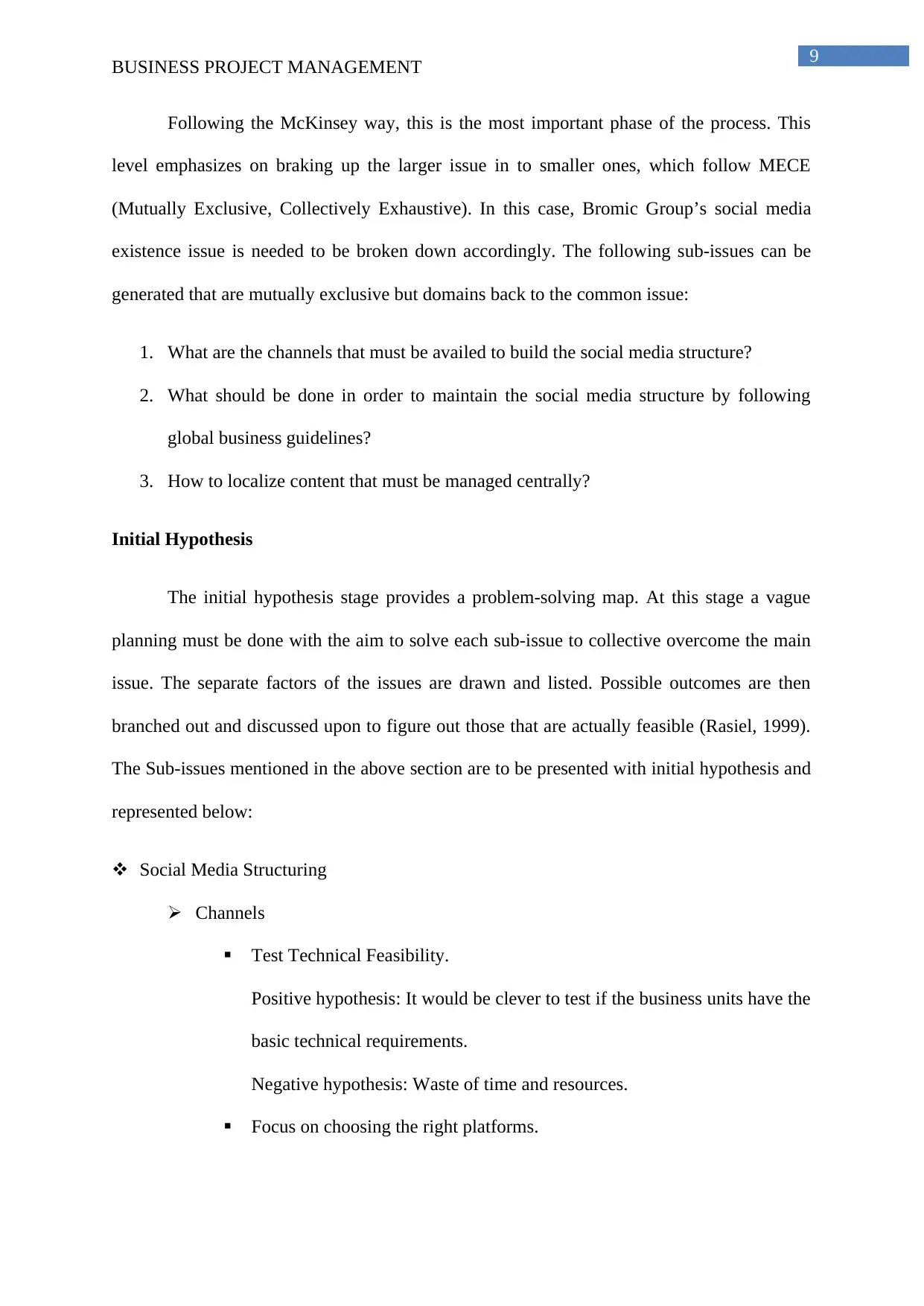
9
BUSINESS PROJECT MANAGEMENT
Following the McKinsey way, this is the most important phase of the process. This
level emphasizes on braking up the larger issue in to smaller ones, which follow MECE
(Mutually Exclusive, Collectively Exhaustive). In this case, Bromic Group’s social media
existence issue is needed to be broken down accordingly. The following sub-issues can be
generated that are mutually exclusive but domains back to the common issue:
1. What are the channels that must be availed to build the social media structure?
2. What should be done in order to maintain the social media structure by following
global business guidelines?
3. How to localize content that must be managed centrally?
Initial Hypothesis
The initial hypothesis stage provides a problem-solving map. At this stage a vague
planning must be done with the aim to solve each sub-issue to collective overcome the main
issue. The separate factors of the issues are drawn and listed. Possible outcomes are then
branched out and discussed upon to figure out those that are actually feasible (Rasiel, 1999).
The Sub-issues mentioned in the above section are to be presented with initial hypothesis and
represented below:
Social Media Structuring
Channels
Test Technical Feasibility.
Positive hypothesis: It would be clever to test if the business units have the
basic technical requirements.
Negative hypothesis: Waste of time and resources.
Focus on choosing the right platforms.
BUSINESS PROJECT MANAGEMENT
Following the McKinsey way, this is the most important phase of the process. This
level emphasizes on braking up the larger issue in to smaller ones, which follow MECE
(Mutually Exclusive, Collectively Exhaustive). In this case, Bromic Group’s social media
existence issue is needed to be broken down accordingly. The following sub-issues can be
generated that are mutually exclusive but domains back to the common issue:
1. What are the channels that must be availed to build the social media structure?
2. What should be done in order to maintain the social media structure by following
global business guidelines?
3. How to localize content that must be managed centrally?
Initial Hypothesis
The initial hypothesis stage provides a problem-solving map. At this stage a vague
planning must be done with the aim to solve each sub-issue to collective overcome the main
issue. The separate factors of the issues are drawn and listed. Possible outcomes are then
branched out and discussed upon to figure out those that are actually feasible (Rasiel, 1999).
The Sub-issues mentioned in the above section are to be presented with initial hypothesis and
represented below:
Social Media Structuring
Channels
Test Technical Feasibility.
Positive hypothesis: It would be clever to test if the business units have the
basic technical requirements.
Negative hypothesis: Waste of time and resources.
Focus on choosing the right platforms.
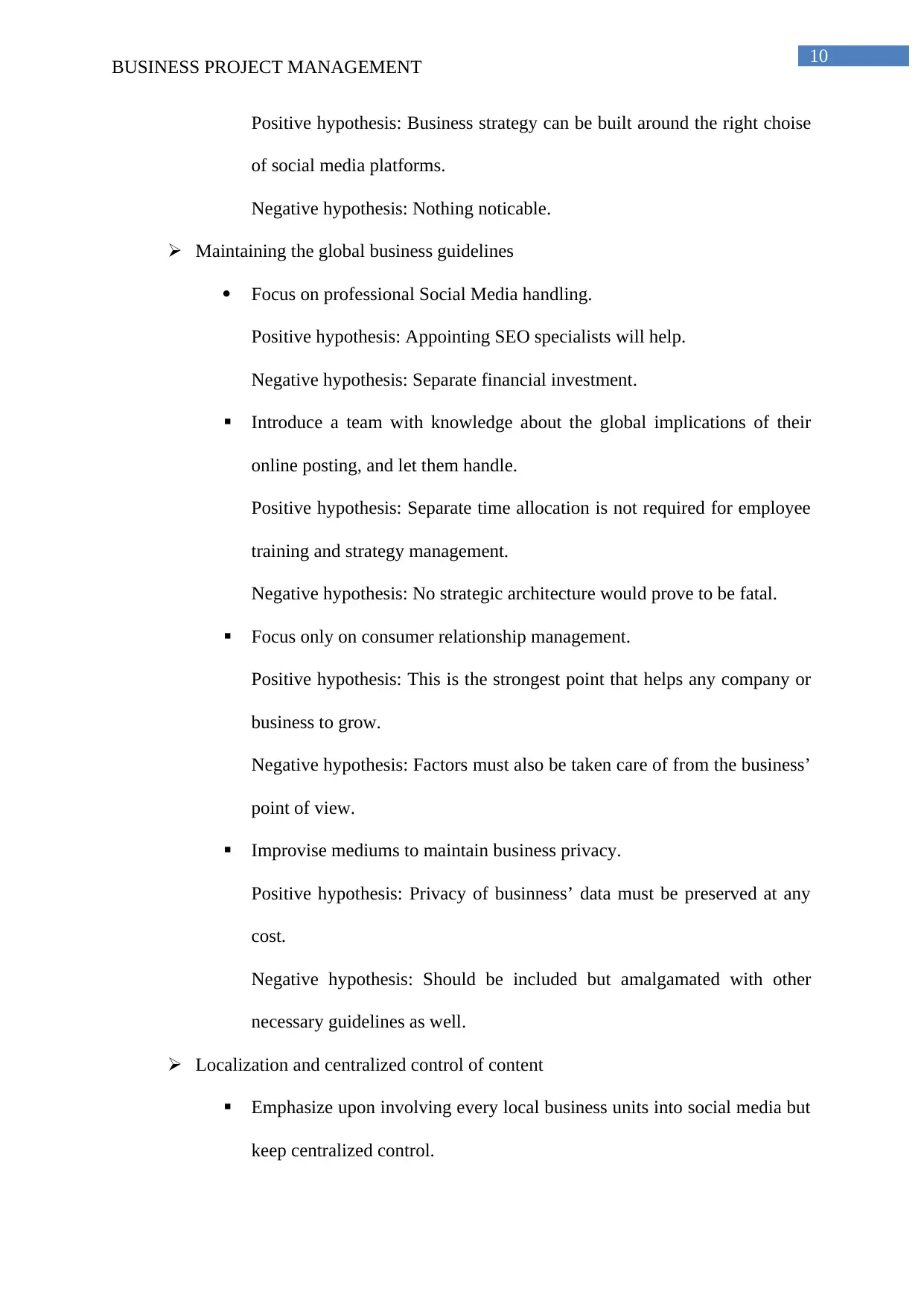
10
BUSINESS PROJECT MANAGEMENT
Positive hypothesis: Business strategy can be built around the right choise
of social media platforms.
Negative hypothesis: Nothing noticable.
Maintaining the global business guidelines
Focus on professional Social Media handling.
Positive hypothesis: Appointing SEO specialists will help.
Negative hypothesis: Separate financial investment.
Introduce a team with knowledge about the global implications of their
online posting, and let them handle.
Positive hypothesis: Separate time allocation is not required for employee
training and strategy management.
Negative hypothesis: No strategic architecture would prove to be fatal.
Focus only on consumer relationship management.
Positive hypothesis: This is the strongest point that helps any company or
business to grow.
Negative hypothesis: Factors must also be taken care of from the business’
point of view.
Improvise mediums to maintain business privacy.
Positive hypothesis: Privacy of businness’ data must be preserved at any
cost.
Negative hypothesis: Should be included but amalgamated with other
necessary guidelines as well.
Localization and centralized control of content
Emphasize upon involving every local business units into social media but
keep centralized control.
BUSINESS PROJECT MANAGEMENT
Positive hypothesis: Business strategy can be built around the right choise
of social media platforms.
Negative hypothesis: Nothing noticable.
Maintaining the global business guidelines
Focus on professional Social Media handling.
Positive hypothesis: Appointing SEO specialists will help.
Negative hypothesis: Separate financial investment.
Introduce a team with knowledge about the global implications of their
online posting, and let them handle.
Positive hypothesis: Separate time allocation is not required for employee
training and strategy management.
Negative hypothesis: No strategic architecture would prove to be fatal.
Focus only on consumer relationship management.
Positive hypothesis: This is the strongest point that helps any company or
business to grow.
Negative hypothesis: Factors must also be taken care of from the business’
point of view.
Improvise mediums to maintain business privacy.
Positive hypothesis: Privacy of businness’ data must be preserved at any
cost.
Negative hypothesis: Should be included but amalgamated with other
necessary guidelines as well.
Localization and centralized control of content
Emphasize upon involving every local business units into social media but
keep centralized control.
Secure Best Marks with AI Grader
Need help grading? Try our AI Grader for instant feedback on your assignments.
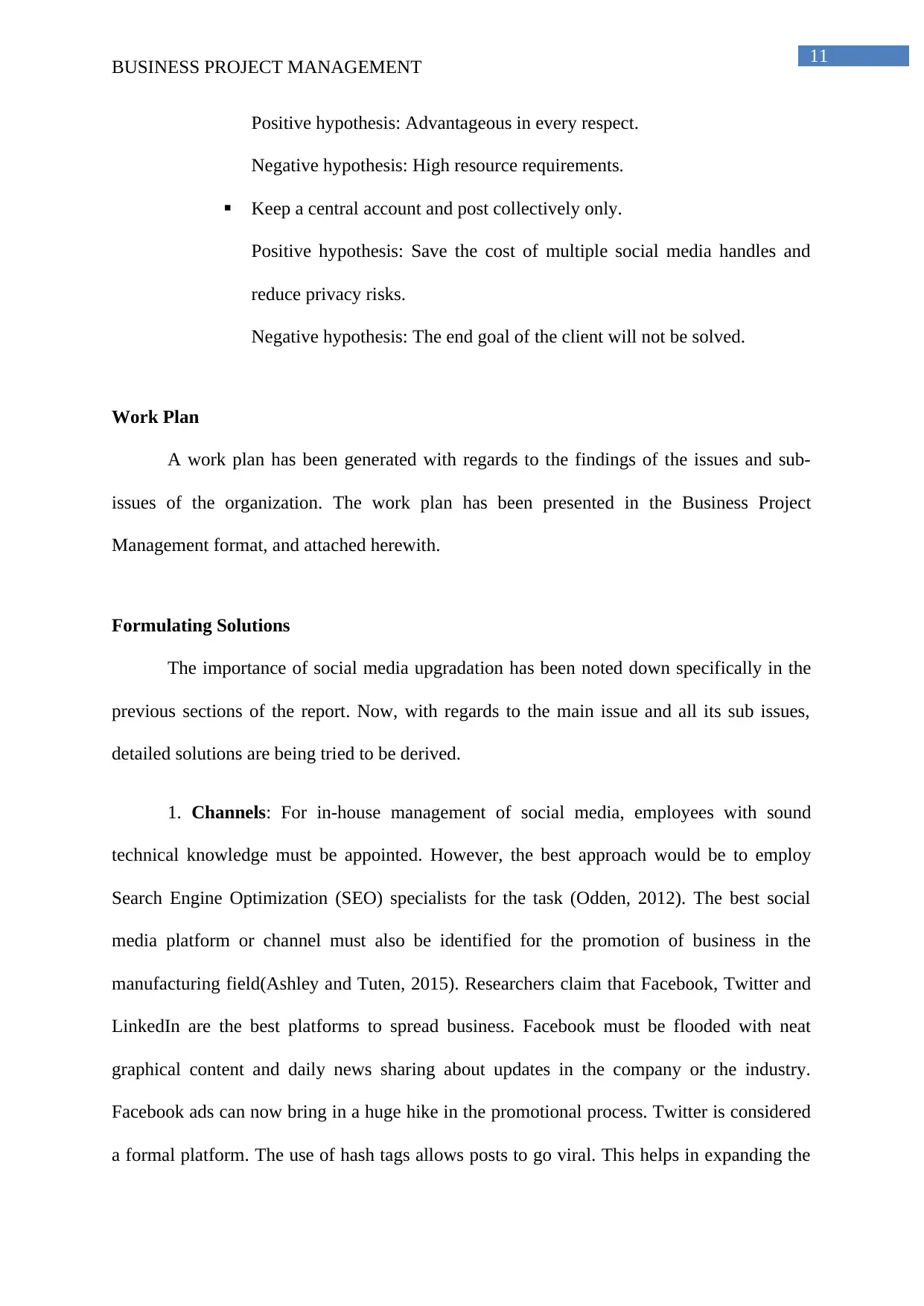
11
BUSINESS PROJECT MANAGEMENT
Positive hypothesis: Advantageous in every respect.
Negative hypothesis: High resource requirements.
Keep a central account and post collectively only.
Positive hypothesis: Save the cost of multiple social media handles and
reduce privacy risks.
Negative hypothesis: The end goal of the client will not be solved.
Work Plan
A work plan has been generated with regards to the findings of the issues and sub-
issues of the organization. The work plan has been presented in the Business Project
Management format, and attached herewith.
Formulating Solutions
The importance of social media upgradation has been noted down specifically in the
previous sections of the report. Now, with regards to the main issue and all its sub issues,
detailed solutions are being tried to be derived.
1. Channels: For in-house management of social media, employees with sound
technical knowledge must be appointed. However, the best approach would be to employ
Search Engine Optimization (SEO) specialists for the task (Odden, 2012). The best social
media platform or channel must also be identified for the promotion of business in the
manufacturing field(Ashley and Tuten, 2015). Researchers claim that Facebook, Twitter and
LinkedIn are the best platforms to spread business. Facebook must be flooded with neat
graphical content and daily news sharing about updates in the company or the industry.
Facebook ads can now bring in a huge hike in the promotional process. Twitter is considered
a formal platform. The use of hash tags allows posts to go viral. This helps in expanding the
BUSINESS PROJECT MANAGEMENT
Positive hypothesis: Advantageous in every respect.
Negative hypothesis: High resource requirements.
Keep a central account and post collectively only.
Positive hypothesis: Save the cost of multiple social media handles and
reduce privacy risks.
Negative hypothesis: The end goal of the client will not be solved.
Work Plan
A work plan has been generated with regards to the findings of the issues and sub-
issues of the organization. The work plan has been presented in the Business Project
Management format, and attached herewith.
Formulating Solutions
The importance of social media upgradation has been noted down specifically in the
previous sections of the report. Now, with regards to the main issue and all its sub issues,
detailed solutions are being tried to be derived.
1. Channels: For in-house management of social media, employees with sound
technical knowledge must be appointed. However, the best approach would be to employ
Search Engine Optimization (SEO) specialists for the task (Odden, 2012). The best social
media platform or channel must also be identified for the promotion of business in the
manufacturing field(Ashley and Tuten, 2015). Researchers claim that Facebook, Twitter and
LinkedIn are the best platforms to spread business. Facebook must be flooded with neat
graphical content and daily news sharing about updates in the company or the industry.
Facebook ads can now bring in a huge hike in the promotional process. Twitter is considered
a formal platform. The use of hash tags allows posts to go viral. This helps in expanding the
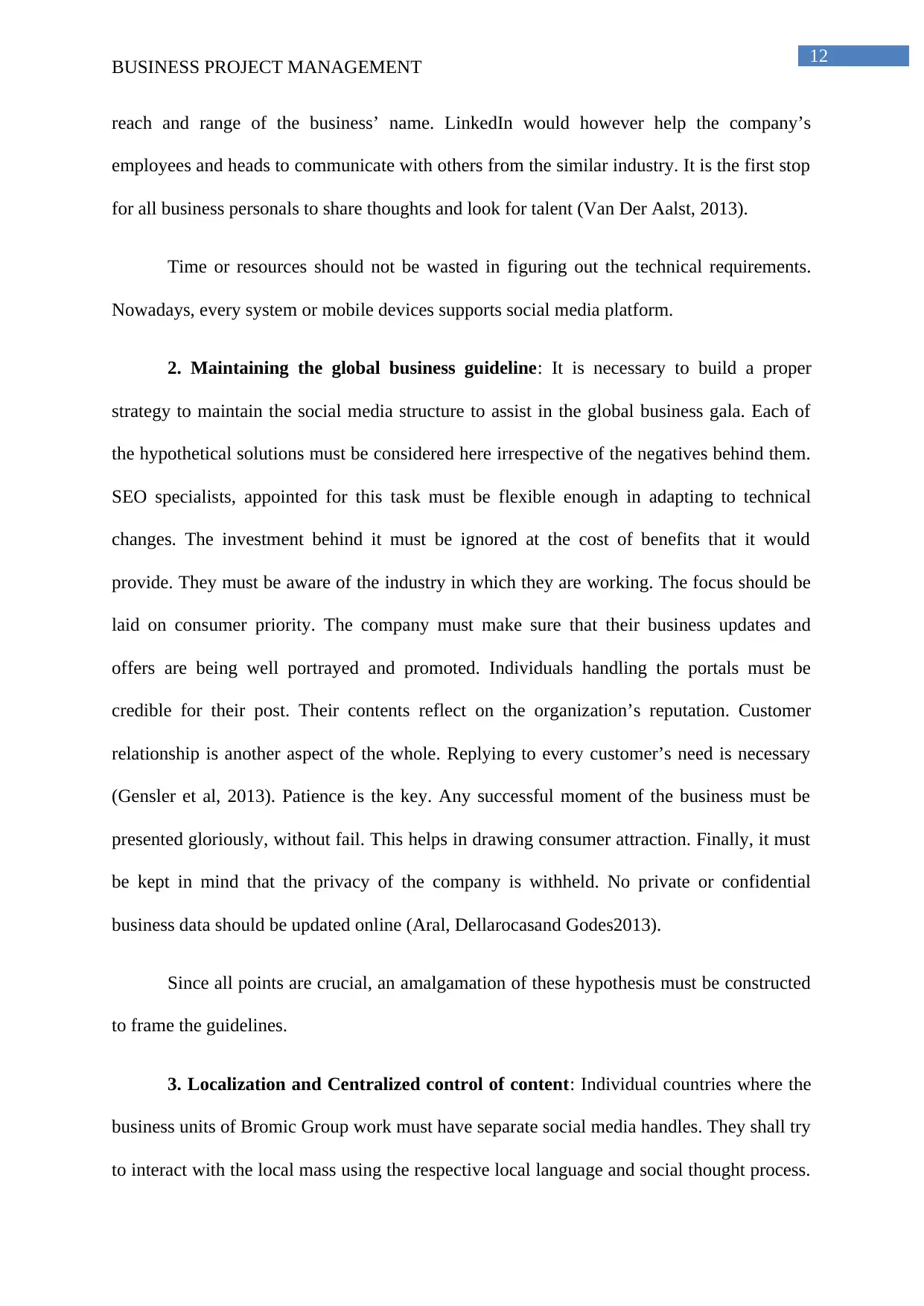
12
BUSINESS PROJECT MANAGEMENT
reach and range of the business’ name. LinkedIn would however help the company’s
employees and heads to communicate with others from the similar industry. It is the first stop
for all business personals to share thoughts and look for talent (Van Der Aalst, 2013).
Time or resources should not be wasted in figuring out the technical requirements.
Nowadays, every system or mobile devices supports social media platform.
2. Maintaining the global business guideline: It is necessary to build a proper
strategy to maintain the social media structure to assist in the global business gala. Each of
the hypothetical solutions must be considered here irrespective of the negatives behind them.
SEO specialists, appointed for this task must be flexible enough in adapting to technical
changes. The investment behind it must be ignored at the cost of benefits that it would
provide. They must be aware of the industry in which they are working. The focus should be
laid on consumer priority. The company must make sure that their business updates and
offers are being well portrayed and promoted. Individuals handling the portals must be
credible for their post. Their contents reflect on the organization’s reputation. Customer
relationship is another aspect of the whole. Replying to every customer’s need is necessary
(Gensler et al, 2013). Patience is the key. Any successful moment of the business must be
presented gloriously, without fail. This helps in drawing consumer attraction. Finally, it must
be kept in mind that the privacy of the company is withheld. No private or confidential
business data should be updated online (Aral, Dellarocasand Godes2013).
Since all points are crucial, an amalgamation of these hypothesis must be constructed
to frame the guidelines.
3. Localization and Centralized control of content: Individual countries where the
business units of Bromic Group work must have separate social media handles. They shall try
to interact with the local mass using the respective local language and social thought process.
BUSINESS PROJECT MANAGEMENT
reach and range of the business’ name. LinkedIn would however help the company’s
employees and heads to communicate with others from the similar industry. It is the first stop
for all business personals to share thoughts and look for talent (Van Der Aalst, 2013).
Time or resources should not be wasted in figuring out the technical requirements.
Nowadays, every system or mobile devices supports social media platform.
2. Maintaining the global business guideline: It is necessary to build a proper
strategy to maintain the social media structure to assist in the global business gala. Each of
the hypothetical solutions must be considered here irrespective of the negatives behind them.
SEO specialists, appointed for this task must be flexible enough in adapting to technical
changes. The investment behind it must be ignored at the cost of benefits that it would
provide. They must be aware of the industry in which they are working. The focus should be
laid on consumer priority. The company must make sure that their business updates and
offers are being well portrayed and promoted. Individuals handling the portals must be
credible for their post. Their contents reflect on the organization’s reputation. Customer
relationship is another aspect of the whole. Replying to every customer’s need is necessary
(Gensler et al, 2013). Patience is the key. Any successful moment of the business must be
presented gloriously, without fail. This helps in drawing consumer attraction. Finally, it must
be kept in mind that the privacy of the company is withheld. No private or confidential
business data should be updated online (Aral, Dellarocasand Godes2013).
Since all points are crucial, an amalgamation of these hypothesis must be constructed
to frame the guidelines.
3. Localization and Centralized control of content: Individual countries where the
business units of Bromic Group work must have separate social media handles. They shall try
to interact with the local mass using the respective local language and social thought process.
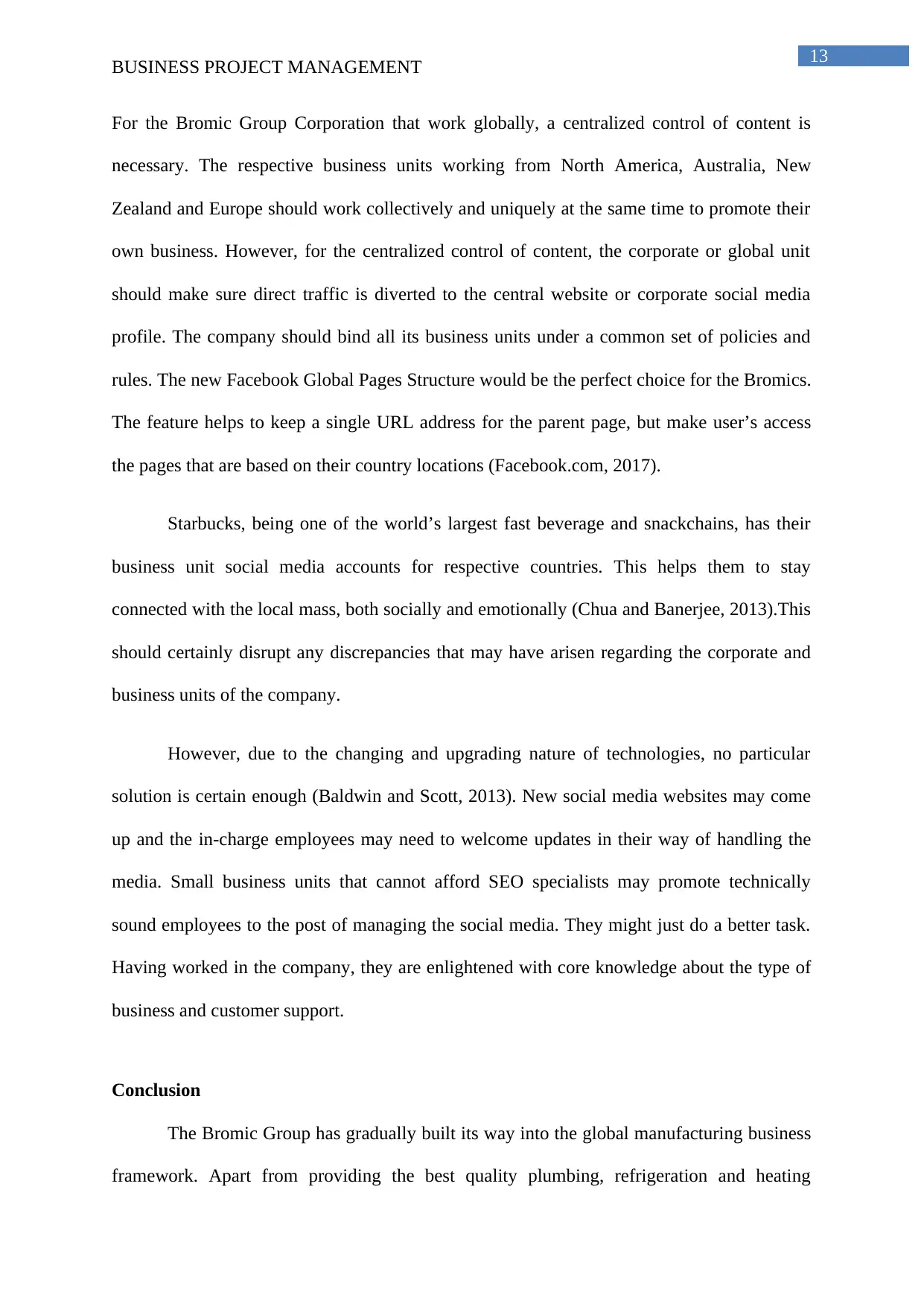
13
BUSINESS PROJECT MANAGEMENT
For the Bromic Group Corporation that work globally, a centralized control of content is
necessary. The respective business units working from North America, Australia, New
Zealand and Europe should work collectively and uniquely at the same time to promote their
own business. However, for the centralized control of content, the corporate or global unit
should make sure direct traffic is diverted to the central website or corporate social media
profile. The company should bind all its business units under a common set of policies and
rules. The new Facebook Global Pages Structure would be the perfect choice for the Bromics.
The feature helps to keep a single URL address for the parent page, but make user’s access
the pages that are based on their country locations (Facebook.com, 2017).
Starbucks, being one of the world’s largest fast beverage and snackchains, has their
business unit social media accounts for respective countries. This helps them to stay
connected with the local mass, both socially and emotionally (Chua and Banerjee, 2013).This
should certainly disrupt any discrepancies that may have arisen regarding the corporate and
business units of the company.
However, due to the changing and upgrading nature of technologies, no particular
solution is certain enough (Baldwin and Scott, 2013). New social media websites may come
up and the in-charge employees may need to welcome updates in their way of handling the
media. Small business units that cannot afford SEO specialists may promote technically
sound employees to the post of managing the social media. They might just do a better task.
Having worked in the company, they are enlightened with core knowledge about the type of
business and customer support.
Conclusion
The Bromic Group has gradually built its way into the global manufacturing business
framework. Apart from providing the best quality plumbing, refrigeration and heating
BUSINESS PROJECT MANAGEMENT
For the Bromic Group Corporation that work globally, a centralized control of content is
necessary. The respective business units working from North America, Australia, New
Zealand and Europe should work collectively and uniquely at the same time to promote their
own business. However, for the centralized control of content, the corporate or global unit
should make sure direct traffic is diverted to the central website or corporate social media
profile. The company should bind all its business units under a common set of policies and
rules. The new Facebook Global Pages Structure would be the perfect choice for the Bromics.
The feature helps to keep a single URL address for the parent page, but make user’s access
the pages that are based on their country locations (Facebook.com, 2017).
Starbucks, being one of the world’s largest fast beverage and snackchains, has their
business unit social media accounts for respective countries. This helps them to stay
connected with the local mass, both socially and emotionally (Chua and Banerjee, 2013).This
should certainly disrupt any discrepancies that may have arisen regarding the corporate and
business units of the company.
However, due to the changing and upgrading nature of technologies, no particular
solution is certain enough (Baldwin and Scott, 2013). New social media websites may come
up and the in-charge employees may need to welcome updates in their way of handling the
media. Small business units that cannot afford SEO specialists may promote technically
sound employees to the post of managing the social media. They might just do a better task.
Having worked in the company, they are enlightened with core knowledge about the type of
business and customer support.
Conclusion
The Bromic Group has gradually built its way into the global manufacturing business
framework. Apart from providing the best quality plumbing, refrigeration and heating
Paraphrase This Document
Need a fresh take? Get an instant paraphrase of this document with our AI Paraphraser
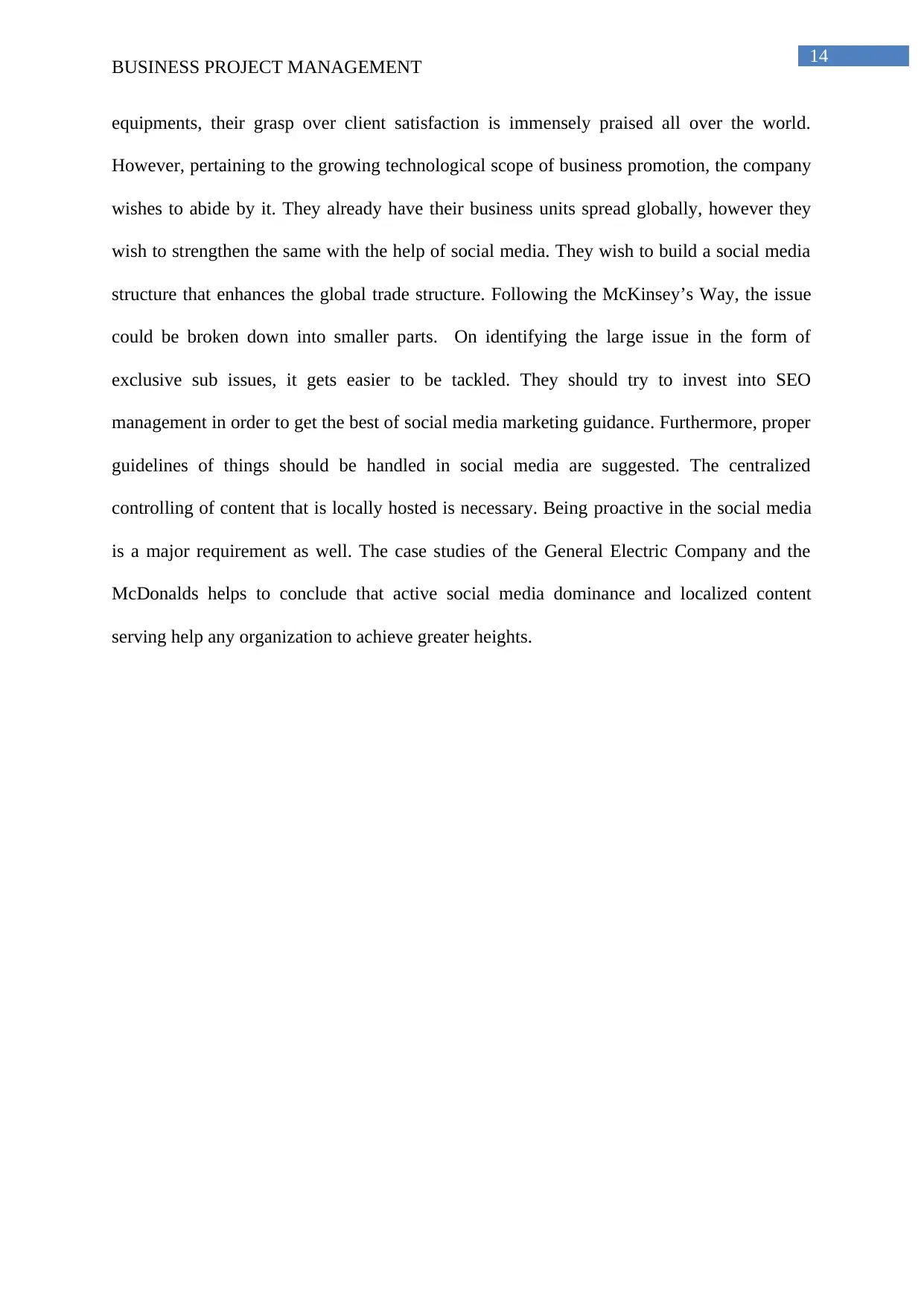
14
BUSINESS PROJECT MANAGEMENT
equipments, their grasp over client satisfaction is immensely praised all over the world.
However, pertaining to the growing technological scope of business promotion, the company
wishes to abide by it. They already have their business units spread globally, however they
wish to strengthen the same with the help of social media. They wish to build a social media
structure that enhances the global trade structure. Following the McKinsey’s Way, the issue
could be broken down into smaller parts. On identifying the large issue in the form of
exclusive sub issues, it gets easier to be tackled. They should try to invest into SEO
management in order to get the best of social media marketing guidance. Furthermore, proper
guidelines of things should be handled in social media are suggested. The centralized
controlling of content that is locally hosted is necessary. Being proactive in the social media
is a major requirement as well. The case studies of the General Electric Company and the
McDonalds helps to conclude that active social media dominance and localized content
serving help any organization to achieve greater heights.
BUSINESS PROJECT MANAGEMENT
equipments, their grasp over client satisfaction is immensely praised all over the world.
However, pertaining to the growing technological scope of business promotion, the company
wishes to abide by it. They already have their business units spread globally, however they
wish to strengthen the same with the help of social media. They wish to build a social media
structure that enhances the global trade structure. Following the McKinsey’s Way, the issue
could be broken down into smaller parts. On identifying the large issue in the form of
exclusive sub issues, it gets easier to be tackled. They should try to invest into SEO
management in order to get the best of social media marketing guidance. Furthermore, proper
guidelines of things should be handled in social media are suggested. The centralized
controlling of content that is locally hosted is necessary. Being proactive in the social media
is a major requirement as well. The case studies of the General Electric Company and the
McDonalds helps to conclude that active social media dominance and localized content
serving help any organization to achieve greater heights.
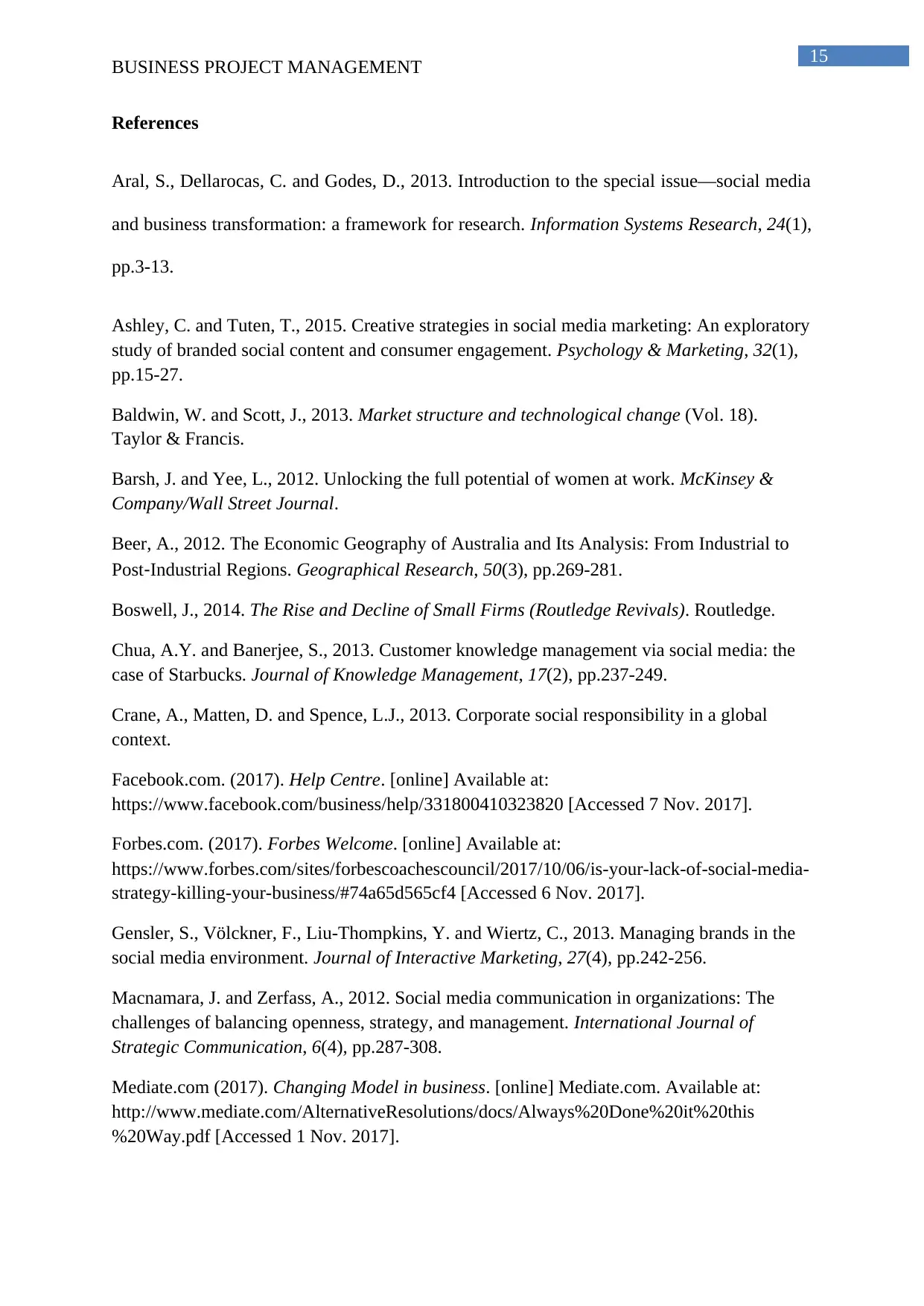
15
BUSINESS PROJECT MANAGEMENT
References
Aral, S., Dellarocas, C. and Godes, D., 2013. Introduction to the special issue—social media
and business transformation: a framework for research. Information Systems Research, 24(1),
pp.3-13.
Ashley, C. and Tuten, T., 2015. Creative strategies in social media marketing: An exploratory
study of branded social content and consumer engagement. Psychology & Marketing, 32(1),
pp.15-27.
Baldwin, W. and Scott, J., 2013. Market structure and technological change (Vol. 18).
Taylor & Francis.
Barsh, J. and Yee, L., 2012. Unlocking the full potential of women at work. McKinsey &
Company/Wall Street Journal.
Beer, A., 2012. The Economic Geography of Australia and Its Analysis: From Industrial to
Post‐Industrial Regions. Geographical Research, 50(3), pp.269-281.
Boswell, J., 2014. The Rise and Decline of Small Firms (Routledge Revivals). Routledge.
Chua, A.Y. and Banerjee, S., 2013. Customer knowledge management via social media: the
case of Starbucks. Journal of Knowledge Management, 17(2), pp.237-249.
Crane, A., Matten, D. and Spence, L.J., 2013. Corporate social responsibility in a global
context.
Facebook.com. (2017). Help Centre. [online] Available at:
https://www.facebook.com/business/help/331800410323820 [Accessed 7 Nov. 2017].
Forbes.com. (2017). Forbes Welcome. [online] Available at:
https://www.forbes.com/sites/forbescoachescouncil/2017/10/06/is-your-lack-of-social-media-
strategy-killing-your-business/#74a65d565cf4 [Accessed 6 Nov. 2017].
Gensler, S., Völckner, F., Liu-Thompkins, Y. and Wiertz, C., 2013. Managing brands in the
social media environment. Journal of Interactive Marketing, 27(4), pp.242-256.
Macnamara, J. and Zerfass, A., 2012. Social media communication in organizations: The
challenges of balancing openness, strategy, and management. International Journal of
Strategic Communication, 6(4), pp.287-308.
Mediate.com (2017). Changing Model in business. [online] Mediate.com. Available at:
http://www.mediate.com/AlternativeResolutions/docs/Always%20Done%20it%20this
%20Way.pdf [Accessed 1 Nov. 2017].
BUSINESS PROJECT MANAGEMENT
References
Aral, S., Dellarocas, C. and Godes, D., 2013. Introduction to the special issue—social media
and business transformation: a framework for research. Information Systems Research, 24(1),
pp.3-13.
Ashley, C. and Tuten, T., 2015. Creative strategies in social media marketing: An exploratory
study of branded social content and consumer engagement. Psychology & Marketing, 32(1),
pp.15-27.
Baldwin, W. and Scott, J., 2013. Market structure and technological change (Vol. 18).
Taylor & Francis.
Barsh, J. and Yee, L., 2012. Unlocking the full potential of women at work. McKinsey &
Company/Wall Street Journal.
Beer, A., 2012. The Economic Geography of Australia and Its Analysis: From Industrial to
Post‐Industrial Regions. Geographical Research, 50(3), pp.269-281.
Boswell, J., 2014. The Rise and Decline of Small Firms (Routledge Revivals). Routledge.
Chua, A.Y. and Banerjee, S., 2013. Customer knowledge management via social media: the
case of Starbucks. Journal of Knowledge Management, 17(2), pp.237-249.
Crane, A., Matten, D. and Spence, L.J., 2013. Corporate social responsibility in a global
context.
Facebook.com. (2017). Help Centre. [online] Available at:
https://www.facebook.com/business/help/331800410323820 [Accessed 7 Nov. 2017].
Forbes.com. (2017). Forbes Welcome. [online] Available at:
https://www.forbes.com/sites/forbescoachescouncil/2017/10/06/is-your-lack-of-social-media-
strategy-killing-your-business/#74a65d565cf4 [Accessed 6 Nov. 2017].
Gensler, S., Völckner, F., Liu-Thompkins, Y. and Wiertz, C., 2013. Managing brands in the
social media environment. Journal of Interactive Marketing, 27(4), pp.242-256.
Macnamara, J. and Zerfass, A., 2012. Social media communication in organizations: The
challenges of balancing openness, strategy, and management. International Journal of
Strategic Communication, 6(4), pp.287-308.
Mediate.com (2017). Changing Model in business. [online] Mediate.com. Available at:
http://www.mediate.com/AlternativeResolutions/docs/Always%20Done%20it%20this
%20Way.pdf [Accessed 1 Nov. 2017].
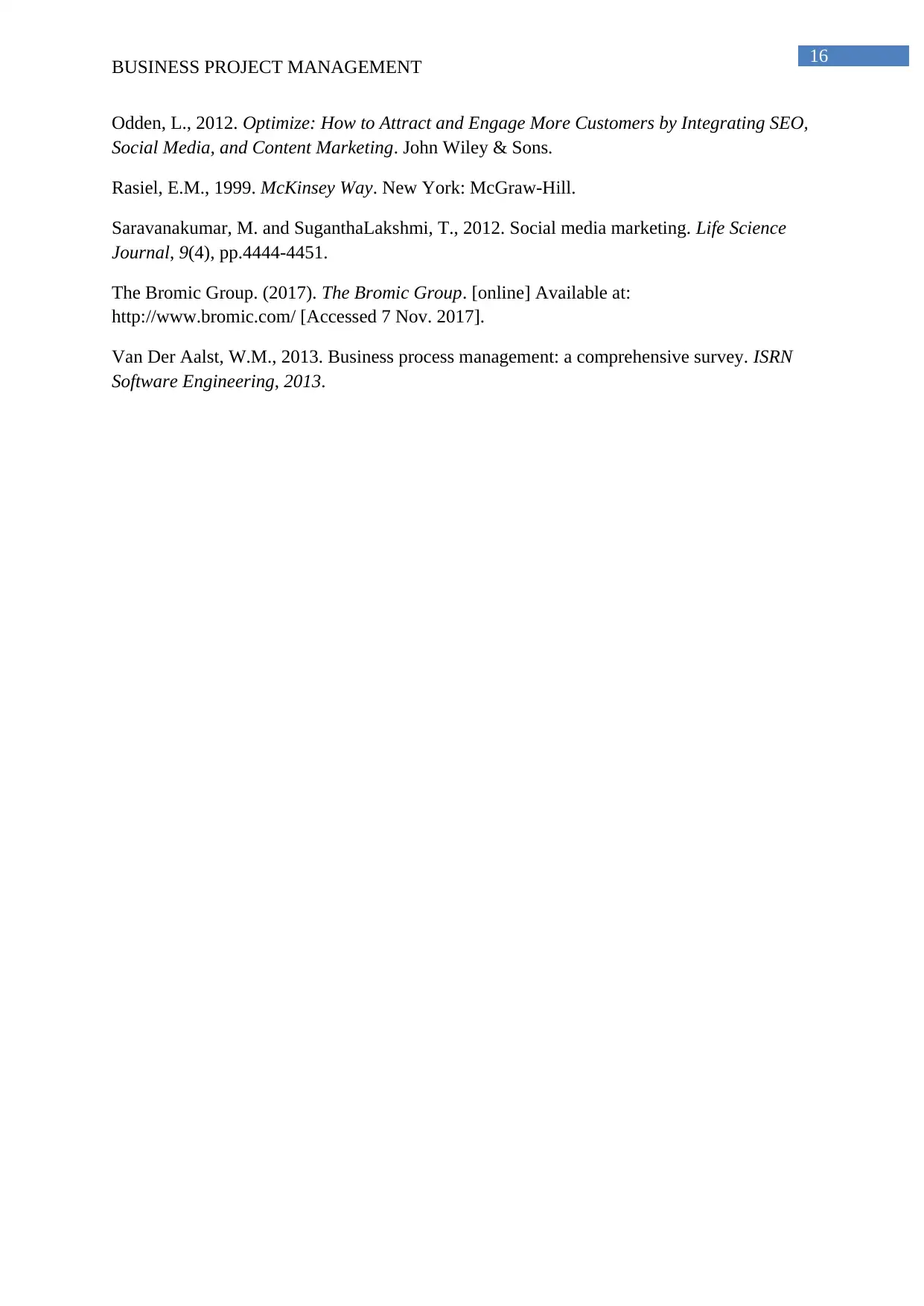
16
BUSINESS PROJECT MANAGEMENT
Odden, L., 2012. Optimize: How to Attract and Engage More Customers by Integrating SEO,
Social Media, and Content Marketing. John Wiley & Sons.
Rasiel, E.M., 1999. McKinsey Way. New York: McGraw-Hill.
Saravanakumar, M. and SuganthaLakshmi, T., 2012. Social media marketing. Life Science
Journal, 9(4), pp.4444-4451.
The Bromic Group. (2017). The Bromic Group. [online] Available at:
http://www.bromic.com/ [Accessed 7 Nov. 2017].
Van Der Aalst, W.M., 2013. Business process management: a comprehensive survey. ISRN
Software Engineering, 2013.
BUSINESS PROJECT MANAGEMENT
Odden, L., 2012. Optimize: How to Attract and Engage More Customers by Integrating SEO,
Social Media, and Content Marketing. John Wiley & Sons.
Rasiel, E.M., 1999. McKinsey Way. New York: McGraw-Hill.
Saravanakumar, M. and SuganthaLakshmi, T., 2012. Social media marketing. Life Science
Journal, 9(4), pp.4444-4451.
The Bromic Group. (2017). The Bromic Group. [online] Available at:
http://www.bromic.com/ [Accessed 7 Nov. 2017].
Van Der Aalst, W.M., 2013. Business process management: a comprehensive survey. ISRN
Software Engineering, 2013.
1 out of 16
Related Documents
Your All-in-One AI-Powered Toolkit for Academic Success.
+13062052269
info@desklib.com
Available 24*7 on WhatsApp / Email
![[object Object]](/_next/static/media/star-bottom.7253800d.svg)
Unlock your academic potential
© 2024 | Zucol Services PVT LTD | All rights reserved.




